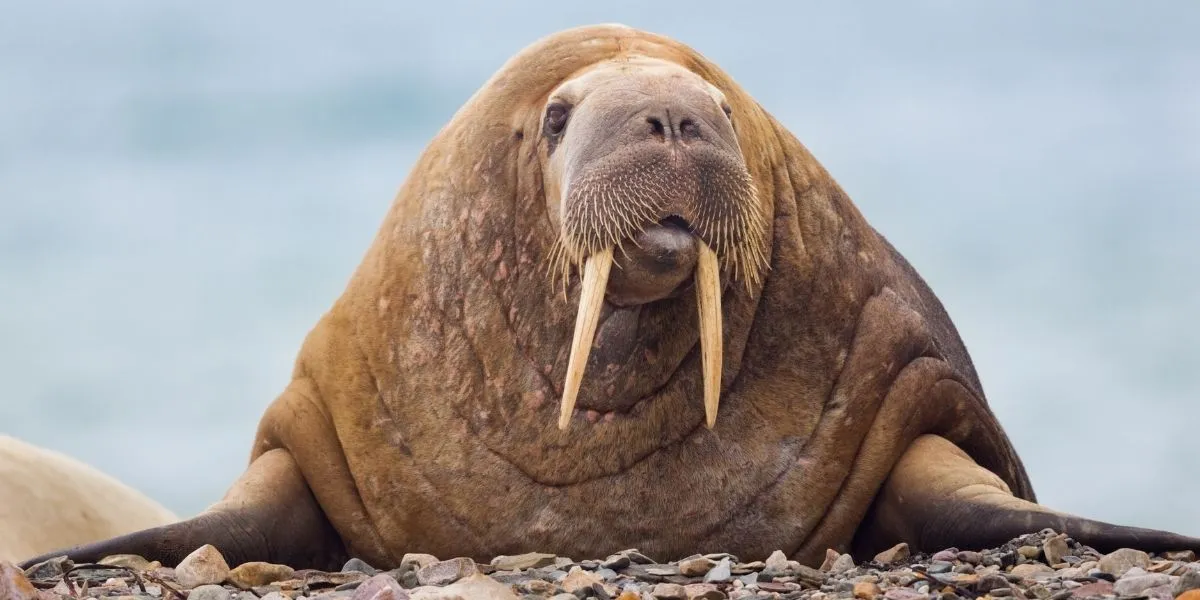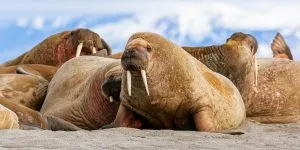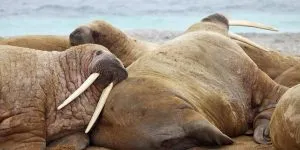Walruses are iconic marine mammals that are found in the northern hemisphere, within the Pacific, Atlantic, and Arctic Oceans. They are known for being quite large, so they must consume a lot of food. What food do they eat, and how?
Walruses are highly specialized at hunting organisms that live in or around the substrate. They mainly eat a range of invertebrates. However, when their preferred prey is not available, they can eat larger organisms including other mammals!
Keep reading to find out more about the diet of walruses, and the techniques they use to locate and eat their prey.
What Do Walruses Eat?
Walruses are carnivorous which means that they only eat other animals, they do not eat plants.
The different subspecies of walrus have very similar diets. Walruses prefer to eat mollusks (such as clams) over any other organism.
However, they are not picky eaters. If mollusks are not easily available, they will supplement their diet with other prey, this might include crabs, shrimp, worms, snails, sea cucumbers, and squid1 (source: WWF).
They like to eat many of these bottom-dwelling (benthic) invertebrates because they have soft tissue. In captivity, walrus are fed predominantly on clams2 (source: Seaworld).
However, their diet isn’t limited to these vertebrates found at the bottom of the ocean. They are also known to eat seabirds, seals, and fish. Walrus are only likely to eat these organisms if they need to.
A walrus would need to diversify its diet if mollusks are not accessible. Mollusks and other invertebrates would be less accessible if they are restricted by ice – this makes them unable to dive3 (source: How Stuff Works).
How Do Walruses Locate Their Prey?
Walruses generally hunt their prey in shallow water between 10-50 meters (33-164 feet). This is because their prey is more abundant at these depths. They can also catch their food in deeper waters of between 80-100 meters if needed4 (source: Alaska Department of Fish and Game).
Walruses use their whiskers (called vibrissae by scientists) on their upper lip to help them locate prey. This is because the waters which walruses typically hunt in are murky and have low visibility5 (source: Wikipedia). They are attached to muscles which makes them very sensitive, see our full guide to Walrus whiskers for more fun facts.
Walruses are also known to forage on top of the sea ice. This occurs when the ice restricts them from diving. If walruses can not dive, then they can not forage for mollusks. The walruses will then use the sea ice to opportunistically hunt different organisms, such as those mentioned earlier.
How Do Walruses Catch Their Food?
Walruses often need to remove their prey from the substrate. This is particularly necessary for catching benthic prey such as some invertebrates. Walruses remove their prey from the substrate in numerous ways.
One way that walruses catch invertebrates is by squirting water from their mouth or nose to unsettle sediment6 (source: Seaworld). Walruses also dislodge sediment to uncover prey using their flipper – this behavior has been recorded particularly in the Atlantic walruses. There is also some evidence that walruses prefer to use their right flipper for this7 (source: N. Levermann, BMC Ecology, Vol.3, No. 9, 2003).
When hunting invertebrates, walruses can also use oral suction to remove their prey directly from the substrate. This oral suction technique benefits that they can manipulate their prey within their mouth.
This means that they can remove the hard shell which may be attached to their prey, and just eat their soft body tissue. Sometimes, this is unnecessary as the suction can be so powerful that it removes the organism completely from its shell 8(source: R.A. Kasteline, Aquatic Mammals, Vol 26(3), pp.175-190, 2000).
Walruses have even been recorded to suction clams out of 30cm deep substrate. Sometimes walruses ingest more than just their prey; small stones have been discovered in the stomach contents of walruses9(source: G.Sheffield, Marine Mammal Science, Vol. 17, Issue. 2, 2001, pp.310-330).
How Do Walruses Eat?
Walruses eat using an oral suction method. This allows them to extract the soft tissue away from the shell. They do this by using their mouth to create a powerful vacuum. They press their lips tightly together and around the shell before rapidly withdrawing its tongue.
Walruses do not chew their food, despite most having 18 teeth and some having up to 3210 (source: N. V. Kryukova, Biology Bulletin, Vol. 39, pp. 618–626, 2012). They often swallow their prey whole.
Sometimes walruses use their teeth to crush shells in their mouth however this is not the cause for abrasion seen in walrus teeth. Instead, walrus teeth get worn down by sand particles which are suctioned up alongside invertebrates11 (source: Seaworld).
How Much Does a Walrus Eat?
The weight of a walrus can be anywhere between 800kg and 1700kg depending upon the sub-species and gender, this means they need to eat a lot! Walruses can fill their stomachs twice per day. Within a single day, an adult walrus generally eats between 3-6% of its body weight.
In order to eat this volume of food, a walrus can consume more than 60 clams per dive – divers generally only last between 5 to 20 minutes! This results in between 3,000 to 6,000 clams being consumed per adult walrus in a single feeding season.
If a walrus is pregnant, it eats a higher volume of food – by about between 30 and 40% more. Walruses also generally consume more food during the summer months compared to winter or spring. During the summer months, walruses spend most of their day foraging12 (source: Seaworld).
Related Questions
Do Walruses Eat Fish?
Yes, walruses can eat fish. However, fish are not a preferred option within a walrus diet. The fish which is typically consumed by walruses is the Arctic cod. In captivity, walrus are often fed herring and capelin 13(source: R.A. Kasteline, Aquatic Mammals, Vol 26(3), pp.175-190, 2000).
Do Walruses Eat Seals?
Yes, walruses are known to eat seals although it is not their preferred diet and is quite rare among most of the population14 (source: L. F. Lowry & F. H. Fay, Polar Biology, Vol. 3, pp. 11–18, 1984). Walruses are particularly known to have eaten the carcasses of young seals when food is very scarce.
Some walruses’ diet depends on seals as the main food source. The seals which are typically eaten by these rare and habitual walruses are bearded seals and ringed seals15 (source: Seaworld).
Do Walruses Eat Penguins?
No, walruses do not eat penguins. Walruses live in the northern hemisphere, and penguins live in the southern hemisphere so the two species do not cross paths.
Do Walruses Eat Humans?
No, walruses do not eat humans although there have been cases where walrus have inflicted damage to explorers and Inuit communities.
Conversely, walrus populations have a long history of being hunted by humans. Presently, it is only legal for Inuit communities to hunt walruses. Walruses are sometimes eaten by Inuit communities16 (source: J. Bennett, Canadian Geographic, 2014).
Do Walruses Eat Worms?
Yes, walruses do eat worms. The worms which walrus eat include the polychaete, echiurid, and sipunculid. These worms were the least persistent prey in a controlled digestion experiment17 (source: G.Sheffield, Marine Mammal Science, Vol. 17, Issue. 2, 2001, pp.310-330).
Do Walruses Eat Oysters?
Yes, walruses can eat oysters. Oysters are a type of bivalve mollusk similar to clams – the preferred prey for walruses. They are sometimes fed oysters in captivity alongside other invertebrates. However, walruses consume more clams in the wild and in captivity than oysters18 (source: R.A. Kasteline, Aquatic Mammals, Vol 26(3), pp.175-190, 2000).
Do Walruses Eat Polar Bears?
No, walruses do not eat polar bears. There are some examples of conflict between polar bears and walruses. Polar bears are actually natural predators for walruses. However, polar bears more successfully predate on younger walruses because adult walruses are too large and dangerous.





![Read more about the article 16 Tusk-Worthy Facts about Walruses [#7 Will Shock You]](https://polarguidebook.com/wp-content/uploads/2022/09/Walrus-300x200.jpg)